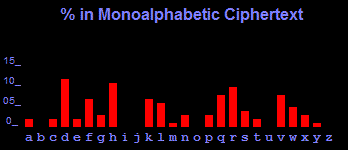If we encrypt the same piece of text using the monoalphabetic substitution cipher and the Vigenère Cipher, we can see why the latter cipher is so much stronger than the former. Let us use a short text about Vigenère to see the difference. Firstly, you can see that the frequency distribution of letters in this messages is fairly typical, with E being the most common letter:
Aged twenty six, Vigènere was sent to Rome on a diplomatic mission. It was here that he became acquainted with the writings of Alberti, Trithemius and Porta, and his interest in cryptography was ignited. For many years, cryptography was nothing more than a tool that helped him his diplomatic work, but at the age of thirty nine, Vigènere decided that he had amassed enough money to be able to abandon his career and concentrate on a life of study. It was only then that he began research into a new cipher.

Now, if you encrypt this message using a monoalphabetic substitution cipher, you can see how the frequency distribution changes:

